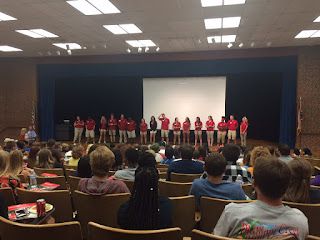What we did:
Everyone entered the classroom and were immediately assigned to one of two cultures (see below.)
- Task One: Learn about your own cultural rules and practice performing in your own culture.
- Task Two: Send two observers to the "other" culture and have two "others" observe your culture.
- Task Three: Two "others" try to immerse themselves in the new culture of each group.
- Task Four: Reflect, reflect, reflect.
I did not have the opportunity to act as "the other" in the activity so did my best to uphold the expectations of the community in which I participated and relied on my peers' experience to learn about the "other."
Who we were:
Anvaya: This is the group with whom I affiliated. The Anvaya group valued community, family and health. We stood in close proximity, often touching each others' arms and shoulders. We shared stories about our family and health, we celebrated life and happiness and shared condolences by gifting cards to our peers. We spoke in turn from eldest to youngest and organically found commonalities within our story-telling.
 Adgantri: The Adgantri group valued profit and competition. They learned a new language that revolved around trading currency. From my understanding, their language allowed them to communicate the suit and number of a deck of cards. They played a game of trading cards in hope to collect a full sequence by suit. I found it interesting that this group also created their own rules - or short-hand language - once they were comfortable.
Adgantri: The Adgantri group valued profit and competition. They learned a new language that revolved around trading currency. From my understanding, their language allowed them to communicate the suit and number of a deck of cards. They played a game of trading cards in hope to collect a full sequence by suit. I found it interesting that this group also created their own rules - or short-hand language - once they were comfortable.How I felt:
I am a bit disappointed in myself that I did not take the "risk" of going to observe or participate in the other community to learn about their culture first-hand. I realize now that I did not jump at the opportunity because of fear. In just learning the rules of my own culture, I was nervous to try and get accustomed to something new where I did not have all of the rules. It is a funny thing how affiliation can feel so strong after only a few moments of shared experience. I see now, however, how that affiliation can be the barrier to new learning and opportunities.

 In the brief experiment, we were able to observe: affiliation development, discomfort in new culture, evolution of culture, and blending or misunderstanding of cultural rules. During our discussion, I imagined myself in new environments and how these aspects do actually happen. I remembered myself as an invited observer of New Zealand higher education institutions versus a self-appointed tourist in Australia. When I walked on the right side of the staircase in Sydney (which I did not even realize was custom in the US), I got scolded by Sydney citizens for being a "typical American" in assuming that everyone world-wide walks/drives on the right side of the street. I could see and understand some elements of this perspective in the BaFa activity.
In the brief experiment, we were able to observe: affiliation development, discomfort in new culture, evolution of culture, and blending or misunderstanding of cultural rules. During our discussion, I imagined myself in new environments and how these aspects do actually happen. I remembered myself as an invited observer of New Zealand higher education institutions versus a self-appointed tourist in Australia. When I walked on the right side of the staircase in Sydney (which I did not even realize was custom in the US), I got scolded by Sydney citizens for being a "typical American" in assuming that everyone world-wide walks/drives on the right side of the street. I could see and understand some elements of this perspective in the BaFa activity.I also remembered what it was like to first join the UC Blue Ash community as a staff member. I remember intentionally looking for clues to the cultural rules, finding allies who were willing to fill in details about the rules and teach me expectations, and eventually being comfortable performing in the community. I think about the feeling rather often when designing and developing elements of new student orientation as well.
Where I can apply this learning:
As the Assistant Director of Orientation & Leadership, it is my responsibility to provide new students an opportunity to transition into the culture of UC Blue Ash. I imagine that new students when they first step on campus, often feel like observers of or immersed into a culture where they do not know all of the rules. This activity helped me realize that my job is to help teach them the language, show them the tools to be successful, and to feel affiliated and connected to our community.


